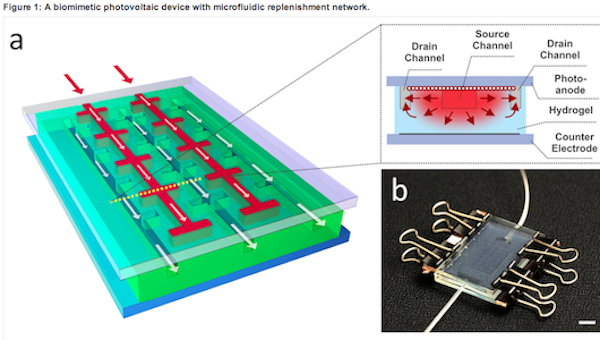
A group of researchers at the North Carolina State University (NCSU) have recently successfully developed solar cells that are able to heal themselves. More specifically, the scientists have successfully been able to solve the problem of dye-sensitized solar cells (DSSC), namely that the dyes used to create energy in these cells would eventually be destroyed by UV radiation.
DSSC cells contain a water-based gel core, electrodes, and inexpensive, light-sensitive, organic dye molecules that capture light and generate electric current. The original cells were created by mimicking the photosynthesis process that occurs in the leaves of plants. In trying to solve the problem of the dyes eventually becoming ineffective due to exposure to UV rays, the NCSU scientists again looked to plants for inspiration. The solar cells they developed contain a network of vascular channels that are very similar to the veins in a leaf, which are used to maintain water and nutrient levels throughout the leaf. The researches found that the needed dyes could be effectively delivered and replenished via this network. The dye that had been rendered ineffective by UV radiation can also be removed through this network.
DSSCs are potentially able to generate electricity even at low levels of light, such as in a shady areas or on overcast days. During testing they have also been able to reach efficiencies that are almost equal to the conventional silicon-based solar cells. Through the work of NCSU researchers one of their major drawbacks, namely losing effectiveness over time, has now apparently been solved.
The other major drawback of DSSC design is that they utilize a liquid electrolyte, which has detrimental temperature stability problems. The electrolyte freezes at low temperatures, which ceases energy production and can physically damage the cells. On the other hand, in times of higher temperatures, the electrolyte liquid expands, meaning that the solar panels cannot be sealed properly.
Mainstream use of DSSC cells in the solar power market may not yet be on the horizon, but these cells are currently already being produced on a large scale for powering gadgets and other mobile devices. A number of companies are also considering developing these cells for building applications, such as embedding them in window glass in an effort to prevent heat loss. With the work of NCSU researchers, these cells are now able to maintain their capacity and efficiency over long periods of time, which certainly brings this promising sustainable technology one step closer to a wider application.
Related Articles on JetsonGreen.com:
Hybrid Solar Tube Panels by Naked Energy
SunPower Readies 24%-Efficient Solar Cell
Australia Wins Solar Decathlon China 2013

Leave a Reply
You must be logged in to post a comment.